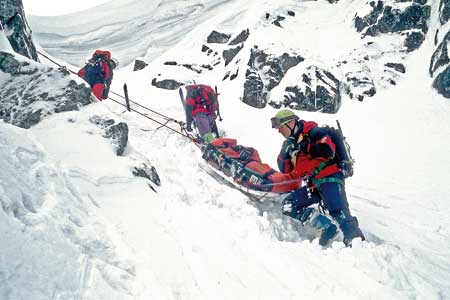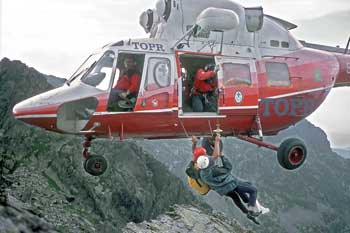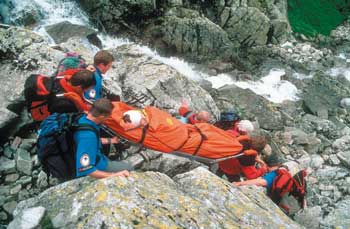| |
RESCUE WORKERS
SPEAK THE SAME LANGUAGE
Mikuláš Argalács (Poprad, Slovacchia)
Marek Grocholski (Zakopane, Polonia)
 The Tatra mines between Poland and Slovakia and the gigantic Italian Alps -on one side we have two new European Union countries (and we should not let ourselves be fooled that it is meaningless), and on the other hand we have one of the founding nations of the European Community. We find a Slavic influence on one side and Latin on the other and yet, despite it all, Slovakian, Polish and Italian mountain rescue workers have found a common language. The Tatra mines between Poland and Slovakia and the gigantic Italian Alps -on one side we have two new European Union countries (and we should not let ourselves be fooled that it is meaningless), and on the other hand we have one of the founding nations of the European Community. We find a Slavic influence on one side and Latin on the other and yet, despite it all, Slovakian, Polish and Italian mountain rescue workers have found a common language.
It was 2006 on the Italian side of Monte Bianco Mountain. It was already dark when four Poles left the Gonella Refuge and came near a steep slope covered in ice near the mountain ridge. Above them, they glimpsed the lights of the group that had left shortly earlier. Tomek Skrzydłowski, a Tatra National Park employee, is not able say whether it was a piece of ice or a rock that hit him. All he remembers was a heavy blow near his clavicle and then a breathless race to the mountain ridge and then…. a terrible pain after the adrenalin had stopped pumping and he was safe. His friends called for rescue, first calling French rescue workers and then the Italian team, but they were unable to understand each other. Tomek does not recall whether it was a language barrier or the screeching wind that was blowing on the mountain that hindered communication. In desperation they called TOPR, the volunteer rescue squad in the Tatra Mountains in Zakopane. Not really certain of the outcome of their phone call, they were   amazed when they heard the roar of helicopter motors above their heads. The men from the Alpine Rescue team treated the wounded man with an analgesic and then immediately transported him to the Aosta hospital. amazed when they heard the roar of helicopter motors above their heads. The men from the Alpine Rescue team treated the wounded man with an analgesic and then immediately transported him to the Aosta hospital.
Mediation by the Tatra rescue team was effective. The mountain rescue workers, made up of the Slavs from Tatra on one side and Italians from the Alps on the other, quickly found a common language. Similar cases have happened in the past. “For example, last year a Polish tourist fractured a leg on the Dolomite Mountains and Italian rescue workers tracked him down thanks to mediations with TOPR”, stated Jan Krzysztof rescue director for the Tatra Mountains in the town of Zakopane. Krzysztof continued “It must be added that collaboration with the Alpine Rescue team was started by the Slovakians. It began in an informal and friendly manner. One of the rescue workers in Tatra had worked in Italy and knew the language and the mountain people.
-Josef Janiga the HZS director stated “We have been working with the Italians for three years and we have carried out six air and land practice drills. We truly appreciate these joint actions and they are an excellent occasion for sharing experiences and comparing the conditions in the Alps and the Tatra Mountains. We want to learn new methods together. We want to organize workshops and sports competitions. We want to carry the interests of mountain rescue to a European Union level. Last year the Slovakians also got Polish rescue workers involved. On December 10, 2008 in Trento a trilateral agreement was signed between the Slovakian HZS, the Italian Finance Police’s Alpine Rescue team  and the Polish TOPR”. and the Polish TOPR”.
-Jan Krzysztof affirmed “Our men have already taken part in helicopter drills in Tatra with the Slovakians and the Italians, and have even travelled to Italy three times. They were invited by the Alpine Rescue team to practice aerial manoeuvres in Courmayer and Sicily and avalanche rescue training with canine support teams in the Passo Rolle zone of the Dolomite Mountains.
Who learns from whom during those drills?
The TOPR director answered “We learn from each other in different areas. Where is the best place to attach the cable under the helicopter? How do you unhook from the cable before entering in the cabin? How do you hoist the stretcher with the injured person aboard? How do you stop the cable from twisting under the helicopter? For example, the rescue workers have perfected a special anti-rotation system and we are going to try and develop something similar”.
Wojciech Mateja, the most athletic of the Tatra rescue workers and a born mountain man whose surname derives from the legendary bandit Madej, took part in the helicopter manoeuvres in Sicily.
-Mateja explained, “It was a routine exercise on rescuing a wounded man from a steep slope or with a cord from along the rocky wall. Our Polish-built ‘Sokół’ helicopter has no reason to envy the American Bell 212 and Bell 412 helicopters that the Italians use. Each day of training ended with a dinner in some establishment with an abundance of good food and wine. The Italian rescue workers are really nice and friendly”, the TOPR rescue worker confirmed.
Italian, German and English readers deserve some information on Tatra and the Tatra rescue workers. The overall surface area of Tatra on the Polish and Slovakian side is around 785 square km. The highest summits reach over 2600 m above sea level. In winter they are covered by ice and snow with frequent freezing temperatures and avalanches. Skiing accidents are also common, even among those who practice downhill skiing. The rocky walls reach up to 900 metres in height and here we find rock climbing accidents. With over 600 caves in these mountains, the rescue workers frequently have to save speleologists who have been injured below earth. The most common injuries are dislocated joints or fractured legs and fainting. There have been a few cases of tourists lost in the fog and even less frequently, hikers have been struck by lightening. Some call to ask for help because they are afraid of the bears. side is around 785 square km. The highest summits reach over 2600 m above sea level. In winter they are covered by ice and snow with frequent freezing temperatures and avalanches. Skiing accidents are also common, even among those who practice downhill skiing. The rocky walls reach up to 900 metres in height and here we find rock climbing accidents. With over 600 caves in these mountains, the rescue workers frequently have to save speleologists who have been injured below earth. The most common injuries are dislocated joints or fractured legs and fainting. There have been a few cases of tourists lost in the fog and even less frequently, hikers have been struck by lightening. Some call to ask for help because they are afraid of the bears.
In the Tatra Mountains the idea of worrying about tourist safety made inroads towards the creation of the Hungarian Carpazi Association on the southern face and the Tatra Association on the northern face.
Both the social organizations were founded in 1873. In comparison the Italian Alpine Club was created exactly ten years earlier. The entire Tatra mountain chain was part of the Austro-Hungarian Empire at the time. The southern section was part of the Kingdom of Hungary and included Slovakia, while the northern section was part of the province of Galicia which included the southern part of current-day Poland.
The idea to create a rescue organization arose after the death of the genius composer Mieczysław Karłowiczy, who lost his life in a skiing accident on February 8, 1909 when he was caught in an avalanche. The volunteer rescue team on Tatra began work in the summer of 1909, even though it was not registered until autumn, on October 29th. The founder and the first director was genius Mariusz Zaruski, a mountain climber, skier, navigator and mounted soldier. Initially rescue was carried out by volunteers. The centennial of the creation of the TOPR will be celebrated in Zakopane during autumn this year.
On the southern side of Tatra, the Tatranská Dobrovoľná Záchranná Komisia was created in 1913, by the initiative of Dr. Michael Guhr, a doctor at the first aid station, to provide rescue services for tourists injured in the mountains. The First World War soon interrupted the commission’s activities. The Československých Turistov Klub carried out rescue activities after the First World War and during the Second World War the Slovenských Turistov Klub in Lyžiarov carried out rescue. All of these activities were operated on a volunteer basis. Over and above the alpine guides, simple refuge captains, police officers, health workers and hotel employees participated in operations. An increase in tourism made it necessary to use professional rescue workers and in 1950 in the municipality of Vysoké Tatry a professional organization made up of three persons developed, the Tatranská Záchranná Služba. Later the Tatranská Horská Služba was built within Tatranský Národní Park. In 2002 the  Slovakian parliament approved a special law to create the Horska Záchranna Služba, a professional rescue organization for the Ministry of the Interiors. Beyond the HZS, the volunteer organization Dobrovoľný Zbor Tatranskej Horskej Služby was also active in the Slovakian Tatras. The Letecká Záchranná Zdravotná Služba carries out aerial rescue using Air Transport Europe Poprad aircraft, which also include Italian manufactured Augusta A109 helicopters. For a few years, the persons rescued by HZS in the Slovakian Tatras have had to pay for the rescue services they received. On the Polish side, rescue is in part financed by the state and in part by profits from tickets to enter Tatra National Park. Slovakian parliament approved a special law to create the Horska Záchranna Služba, a professional rescue organization for the Ministry of the Interiors. Beyond the HZS, the volunteer organization Dobrovoľný Zbor Tatranskej Horskej Služby was also active in the Slovakian Tatras. The Letecká Záchranná Zdravotná Služba carries out aerial rescue using Air Transport Europe Poprad aircraft, which also include Italian manufactured Augusta A109 helicopters. For a few years, the persons rescued by HZS in the Slovakian Tatras have had to pay for the rescue services they received. On the Polish side, rescue is in part financed by the state and in part by profits from tickets to enter Tatra National Park.
The Polish and Slovakian rescue workers have always worked together in the Tatra Mountains. The official collaboratory agreement between HZS and TOPR was finally signed on June 17, 2004. Regular drills and the sporting events are now the rule. The Slovakians are in general faster in Alpine ski competitions and more efficient in training avalanche rescue dogs. The Polish are the best in caves and they managed to save an injured mountain climber with a long cable directly from the rock wall with perfect technique. In 2008 the Poles and the Slovakians carried out seven large-scale rescue operations together. Photo Marcin Józefowicz
|
|


 amazed when they heard the roar of helicopter motors above their heads. The men from the Alpine Rescue team treated the wounded man with an analgesic and then immediately transported him to the Aosta hospital.
amazed when they heard the roar of helicopter motors above their heads. The men from the Alpine Rescue team treated the wounded man with an analgesic and then immediately transported him to the Aosta hospital.  and the Polish TOPR”.
and the Polish TOPR”.  side is around 785 square km. The highest summits reach over 2600 m above sea level. In winter they are covered by ice and snow with frequent freezing temperatures and avalanches. Skiing accidents are also common, even among those who practice downhill skiing. The rocky walls reach up to 900 metres in height and here we find rock climbing accidents. With over 600 caves in these mountains, the rescue workers frequently have to save speleologists who have been injured below earth. The most common injuries are dislocated joints or fractured legs and fainting. There have been a few cases of tourists lost in the fog and even less frequently, hikers have been struck by lightening. Some call to ask for help because they are afraid of the bears.
side is around 785 square km. The highest summits reach over 2600 m above sea level. In winter they are covered by ice and snow with frequent freezing temperatures and avalanches. Skiing accidents are also common, even among those who practice downhill skiing. The rocky walls reach up to 900 metres in height and here we find rock climbing accidents. With over 600 caves in these mountains, the rescue workers frequently have to save speleologists who have been injured below earth. The most common injuries are dislocated joints or fractured legs and fainting. There have been a few cases of tourists lost in the fog and even less frequently, hikers have been struck by lightening. Some call to ask for help because they are afraid of the bears. Slovakian parliament approved a special law to create the Horska Záchranna Služba, a professional rescue organization for the Ministry of the Interiors. Beyond the HZS, the volunteer organization Dobrovoľný Zbor Tatranskej Horskej Služby was also active in the Slovakian Tatras. The Letecká Záchranná Zdravotná Služba carries out aerial rescue using Air Transport Europe Poprad aircraft, which also include Italian manufactured Augusta A109 helicopters. For a few years, the persons rescued by HZS in the Slovakian Tatras have had to pay for the rescue services they received. On the Polish side, rescue is in part financed by the state and in part by profits from tickets to enter Tatra National Park.
Slovakian parliament approved a special law to create the Horska Záchranna Služba, a professional rescue organization for the Ministry of the Interiors. Beyond the HZS, the volunteer organization Dobrovoľný Zbor Tatranskej Horskej Služby was also active in the Slovakian Tatras. The Letecká Záchranná Zdravotná Služba carries out aerial rescue using Air Transport Europe Poprad aircraft, which also include Italian manufactured Augusta A109 helicopters. For a few years, the persons rescued by HZS in the Slovakian Tatras have had to pay for the rescue services they received. On the Polish side, rescue is in part financed by the state and in part by profits from tickets to enter Tatra National Park.